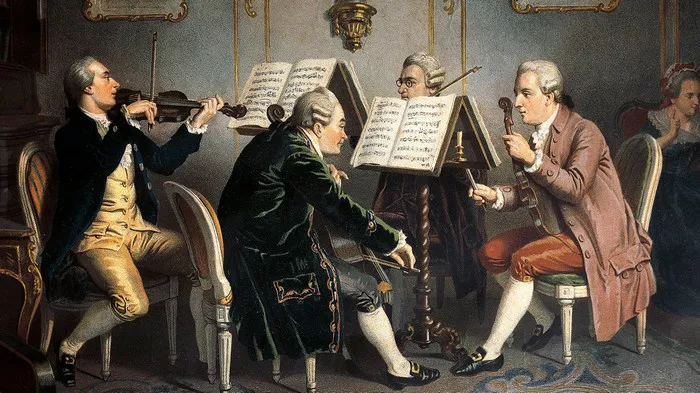The Classical period in Western music, which spans from approximately 1750 to 1820, is renowned for its elegant and balanced compositions. This era witnessed the emergence of several new forms of music that would influence the development of Western music for centuries to come. Two of the most significant forms that arose during this period are the symphony and the string quartet. These forms were not only innovative in their structure and style but also played crucial roles in the evolution of musical composition and performance. This article will delve into the origins, characteristics, and impact of the symphony and the string quartet, providing a comprehensive understanding of their importance in the Classical period.
I. The Symphony: A New Orchestral Form
1. Origins and Development
The symphony evolved from the Italian opera overture, known as the sinfonia. In the early 18th century, the sinfonia was a three-part work (fast-slow-fast) that served as the introduction to an opera. Composers began to appreciate the potential of the sinfonia as an independent orchestral piece, leading to the development of the symphony.
2. Structure and Characteristics
By the mid-18th century, the symphony had established a four-movement structure:
First Movement: Typically in sonata-allegro form, characterized by its fast tempo and dynamic contrasts.
Second Movement: Slower and more lyrical, often in a ternary (ABA) or theme-and-variations form.
Third Movement: A minuet and trio, later replaced by the scherzo by Beethoven, providing a lighter and dance-like character.
Fourth Movement: A fast-paced finale, often in rondo or sonata-allegro form, bringing the symphony to a vigorous close.
3. Key Composers and Works
Franz Joseph Haydn is often referred to as the “Father of the Symphony.” He composed 104 symphonies, with notable examples including Symphony No. 94 in G Major (“Surprise”) and Symphony No. 104 in D Major (“London”). Haydn’s symphonies laid the groundwork for the form, establishing structural and thematic conventions.
Wolfgang Amadeus Mozart also made significant contributions to the symphony. His Symphony No. 40 in G Minor, K. 550, and Symphony No. 41 in C Major, K. 551 (“Jupiter”), are celebrated for their intricate craftsmanship and emotional depth.
Ludwig van Beethoven pushed the boundaries of the symphony, expanding its length, complexity, and expressive range. His Symphony No. 3 in E-flat Major, Op. 55 (“Eroica”), and Symphony No. 9 in D Minor, Op. 125 (“Choral”), exemplify his innovative approach, incorporating new structural elements and thematic development.
4. Impact and Legacy
The symphony became a central form of orchestral music, influencing subsequent generations of composers. It provided a framework for exploring new harmonic, melodic, and rhythmic ideas, and its popularity grew throughout the 19th and 20th centuries. Composers such as Johannes Brahms, Anton Bruckner, Gustav Mahler, and Dmitri Shostakovich continued to develop the symphony, each bringing their unique voice to the form.
II. The String Quartet: Chamber Music Reimagined
1. Origins and Development
The string quartet originated as an extension of the trio sonata, popular in the Baroque period. The ensemble consists of two violins, a viola, and a cello, creating a balanced and versatile combination. The early development of the string quartet is closely linked to the works of Joseph Haydn, who is often called the “Father of the String Quartet.”
2. Structure and Characteristics
The typical string quartet follows a four-movement structure, similar to the symphony:
First Movement: Sonata-allegro form, providing a dynamic and often dramatic opening.
Second Movement: Slow and expressive, allowing for lyrical and contemplative music.
Third Movement: A minuet and trio, later evolving into a scherzo in the hands of Beethoven and later composers.
Fourth Movement: A lively finale, often in rondo or sonata-allegro form, bringing the work to a spirited conclusion.
3. Key Composers and Works
Joseph Haydn played a pivotal role in the development of the string quartet. His Op. 33 quartets, such as the String Quartet in B-flat Major, Op. 33, No. 4, showcase his innovative use of thematic development and conversational interplay between the instruments.
Wolfgang Amadeus Mozart expanded the expressive potential of the string quartet. His six “Haydn” Quartets, dedicated to Haydn, are masterpieces of the genre, with the String Quartet No. 19 in C Major, K. 465 (“Dissonance”), being particularly notable for its bold harmonic exploration.
Ludwig van Beethoven revolutionized the string quartet with his late quartets, such as the String Quartet No. 14 in C-sharp Minor, Op. 131. These works are characterized by their profound emotional depth, structural innovation, and technical demands.
4. Impact and Legacy
The string quartet became a cornerstone of chamber music, offering composers a platform for intimate and sophisticated musical expression. It allowed for intricate interplay between the four instruments, fostering a conversational style that remains a hallmark of the genre. The string quartet’s influence extended into the Romantic period and beyond, inspiring composers like Franz Schubert, Felix Mendelssohn, Johannes Brahms, and Dmitri Shostakovich to create some of their most profound and personal works within this form.
See Also: 6 Classical Music Pieces Inspired by Swans: All You Want to Know
III. Conclusion
The Classical period was a time of significant innovation and transformation in Western music. The development of the symphony and the string quartet as new forms of music during this era played a crucial role in shaping the future of musical composition and performance. These forms provided composers with new opportunities for artistic expression and technical exploration, leading to the creation of some of the most enduring and influential works in the Western classical music canon. The legacy of the symphony and the string quartet continues to resonate in contemporary music, underscoring their enduring significance and impact.

